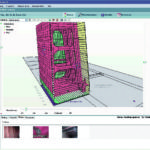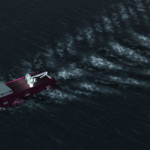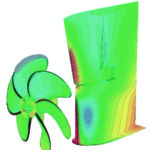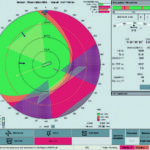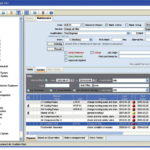Modern IT applications can tap into significant potential for improvement in ship design and operation. This concerns virtually all aspects[ds_preview] of ship operational costs. Fuel costs can be brought down most effectively in design, but also in the operation of the fleet in service. Various tools are now available for intelligent maintenance for structure and machinery, damage avoidance, spare parts management, etc. Tools to support crew management have emerged more recently. The paper gives an overview of existing option illustrated by examples taken from the experience of Germanischer Lloyd’s and its subsidiaries.
Introduction
The global financial crisis has impacted shipping and shipbuilding markets profoundly. After years of high profits and suppliers in positions of strength, we see now the reverse: profits are marginal at best and customers exert pressure on suppliers, charterers on ship owners, ship owners on ship yards, etc. The overall crisis obscures sometimes the fuel cost issue, but fuel costs are expected to remain a major problem for ship operators far beyond the current crisis.
Ship operators are faced with low freight rates and rising costs. The management attention needs to be focused on competitiveness, i.e. on closely looking at options to
1. increase revenues and
2. reduce costs
The freight rates cannot be influenced by an individual shipping company. However a revenue increase is possible via two main levers:
• reduce unplanned off-hire days
• increase attractiveness of the own vessel to the charterer
At the same time, shipping companies typically look at their major cost blocks, which are:
• Fuel costs
• Maintenance and repair costs
• Crew costs
Of course, ship owners have always tried to maximize their revenues and minimize their costs. So what is different now? Today, so far largely untapped potential can be exploited through advanced information technology (IT). Germanischer Lloyd and its subsidiaries support this quest with a wide range of services which can be seen as representative of the frontier state of the art. This will be illustrated by examples in the following.
At the core of many applications stand comprehensive multidimensional models of ship structure and equipment, which can be visualized in 3d displays. A modern product data model (PDM) combines geometry information with other product data, such as material, suppliers, scheduled date of maintenance, etc. Such PDMs, by now standard in maritime applications, are the starting point for a multitude of simulation options and support the rapid exchange with assorted technical and administrative software. However, PDMs are not yet used to their full potential. More advanced applications at navies and classification societies show how industry applications may evolve in the decades to come.
Reduce unplanned off-hire days
Dock time is particularly expensive when it is not scheduled or longer than scheduled. Frequency and duration of dock times can be minimized by good planning, involving ship operator, repair yard and equipment suppliers. For the hull structure, clear specifications are needed for the parts to be replaced. This involves location, scantlings, steel quality etc. The tedious preparation of the required information for the repair yard (part lists, technical drawings for steel parts, welding requirements, etc.) can be produced consistently and rapidly by modern hull maintenance management software like GL HullManager. The information can be supplied electronically to the repair yard, reducing expensive delays. The systematic and consistent format is in addition less error prone that traditional communication. In sum, modern IT helps here to reduce planned time in dock as well as unplanned delays while in dock.
Of course, the hull structure is only one component of an overall maintenance management. The other part concerns the assorted equipment on ships. Due to the diversity of suppliers and products, a separate line of software has evolved, dedicated to the management tasks in equipment maintenance. For example, steel plates of a given quality and thickness are relatively simple to source anywhere in the world. In contrast, specific equipment may be supplied only by one company. A key challenge is then having critical equipment delivered on time when the ship is in the dock. Maintenance schedules need then be connected with sourcing databases and scheduling tasks. The complexity of the task depends on the extent of the equipment on board. For ships with extensive and complex equipment, IT support is vital, for others highly recommended. GL Maritime Software offers its GL ShipManager for this purpose.
Increase attractiveness of the own vessel to the charterer
Competitiveness boils down to essentially three items: cost, time and quality. Offering better quality usually converts into attracting more business at a given price or obtaining higher prices on the market. For ship owners and charterers, a key quality indicator is the condition of the ship (both structure and equipment). As bunker fuel costs are typically the biggest single cost item in ship operation (accounting for 60 % of the daily operation costs of a 4300 TEU containership in late 2009), fuel efficiency is a key indicator for cost competitiveness.
The present market environment is characterized by surplus supply of ships. As a result, customers can choose and suppliers must outperform competition to sell in the market. In order to sell ships or charters, companies must then prove that a ship is
• environmentally friendly and fuel efficient
• well maintained in structure and equipment
• safe to operate, minimizing risks to cargo and hull structure
Ideally, the ship should be all of the above, while being at the same time easy to operate, even by less experienced crews. We shall elaborate in the role of modern IT in achieving these goals.
Reduce fuel costs
There are many ways to decrease the required propulsive power of a ship, Bertram et al. (2009). The most efficient way is of course speed reduction, particularly choosing a lower design speed. Once the optimum speed has been fixed, the task is to minimize the fuel consumption for this speed, subject to safety and operational constraints. Here, the key to exploit existing fuel saving potential lies in modern simulation techniques, Fach (2006), mainly using CFD (Computational Fluid Dynamics).
For given main dimensions, wave resistance offers large design potential. Moderate changes in lines can result in considerable changes of wave resistance. Best business practice is the combination of parametric hull description, multi-criteria optimization algorithms and fully nonlinear wave resistance codes (that typically include a semi-empirical estimation of viscous resistance components), Abt and Harries (2007). Parametric modeling means describing complex forms with a limited number of parameters, typically 50 to 100 in sophisticated applications. This allows fast creation of potential solutions and opens the door for formal optimization. The approach has proven to be effective for virtually all displacement ships, ranging from tankers to semi-planing megayachts, www.futureship.net. Optimization of the aftbody lines requires considerably higher computer resources due to the dominant effects of viscosity and turbulence. However, our pilot applications show the feasibility of the approach and formal optimization of aftbody lines is expected to become soon a standard option in ship design. In this case, the classical wave resistance code is exchanged for a viscous free-surface CFD code that captures also breaking waves, boundary layers and flow separation. Computations are performed on massively parallel computer clusters, which depending on the applications may use more than 500 processors. Viscous CFD codes are also applied in aligning and streamlining appendages which contribute disproportionally to the total fuel consumption. While these applications concern ship design (or re-design), there are related applications for the fleet in service, namely trim optimizations.
For each draft and speed, there is a fuel-optimum trim. For ships with large transom sterns and bulbous bows, the power requirements for the best and worst trim may differ by more than 10 %. Systematic CFD simulations are recommended to assess the best trim and the effect of different trim conditions. Typically, wave resistance codes with simplified propeller models are sufficiently accurate for the purpose. Decision support systems for fuel-optimum trim based on such simulations have been proven to result very cost effective fuel savings, Hansen and Freund (2010).
But fuel can be saved not only by hydrodynamic simulations. At first glance, it is trivial: Smaller ships consume less fuel. But the potential for weight reduction is rarely used to its full extent. Progress in IT tools allows today cost effective weight savings through rapid modeling. Germanischer Lloyd’s Poseidon software is a structural product data modeler with integrated finite element analysis (FEA) code. Poseidon allows relatively fast modeling of the main ship structures. Once the product data model is established, one can compare scantlings automatically against Class Rules and identify where ship structures are overdimensioned. But then more sophisticated FEA simulations should verify that no problems in terms of vibration and fatigue are to be expected. In a recent application, the initial steel weight was reduced by more than 2 % checking first scantlings with Poseidon and then verifying critical spots by FEA. The savings in steel cost alone would have justified the analysis for a single ship. The savings are much larger when considering series of ships and the accumulated fuel savings (which are approximately proportional to the total weight of the ship).
There are various options to save power in the assorted energy consuming equipment onboard ships. The saving potential depends on the ship type, as auxiliary power generators and consumers differ largely. Simulations of the overall machinery system are able to predict fuel consumptions for given operational profile. These simulations allow assessment of alternatives and ultimately better balanced energy profiles. Installed onboard, the current consumption of mechanical and electrical energy can be displayed in combination with the fuel consumption of the engines and their efficiency of power generation, Hansen and Freund (2010). The tool aids thus in design and in operation, leading to a more balanced and thus more efficient energy management. As a secondary effect, a more balanced energy profile reduces also wear and tear, reducing maintenance and repair costs. The maintenance and repair costs are discussed separately in the following.
Reduce repair and maintenance costs
Repair and maintenance costs can be decomposed in several ways. We discuss here hull structure and equipment separately. Maintenance cycles and data models for these two large groups are different, leading naturally also to different tools despite the common basic theme.
For the ship structure, condition assessment schemes (CAS) have evolved dynamically over the past decade, e.g. Cabos et al. (2008). 3d product data models (like POSEIDON) are at the core of condition assessment schemes. These data models describe initially the designed ship structure and the required scantling dimensions following Class rules, as described above. Once the ship is in service, periodic surveys furnish thickness measurements. By automatically entering thickness measurements into the model and standardizing reports, the survey process has been accelerated to the point where the ship owner receives the report on his ship’s condition while it is still in the dry dock. This procedure was first implemented in the PEGASUS software five years ago, Jaramillo and Cabos (2006). While Pegasus is designed for thickness measurement companies, the GL HullManager software is tailored for ship owners. The GL HullManager allows adding photos and descriptions to objects in the product data model. Interactive 3d features have proven to be a very effective tool to support the complete hull integrity management process. The technology has been used for many years in ship design and has more recently migrated into applications in shipping. Data from successive measurement campaigns can be used for trend extrapolation and intelligent preventive maintenance for the hull structure. The technology has been available for several years now, but for various reasons actual implementation in industry practice has lagged behind the technical possibilities.
The hull condition monitoring records corrosion, but also cracks. While corrosion depends largely on proper coating, cracks depend also on the way a crew operates a ship. By choosing appropriate speeds in severe seaways, premature fatigue cracks can be avoided. Advanced short-term routing systems combine data on current near-field seaway with knowledge bases on the seakeeping behavior of a ship to supply decision support to the crew on suitable speed-course combinations. The same information can be used to avoid excessive loads (due to slamming impact), excessive accelerations (leading to sea sickness, excessive loads on lashing systems with subsequent container losses) or excessive roll motions (potentially endangering even the whole ship). Such decision support systems appear in various combinations. The value of the system depends crucially on the quality of the input data, the decision support reasoning and the underlying simulations for the hydrodynamic knowledge base. The GL SeaScout is an example representing the state of the art in this field. The SeaScout developed from the preceding Shipboard Routing Assistance (SRA) system, Rathje and Beiersdorf (2005). The modular architecture allows easy adaptation to new applications (such as fuel consumption reduction through routing) and new sensors.
Besides the hull structure, the assorted equipment onboard a ship needs attention and can benefit from intelligent maintenance and repair strategies. The multitude of systems and parts on a ship together with sometimes considerable delivery times in various parts of the world motivate approaches involving databases of systems and components, combined with largely automated monitoring and assessment functions. The tools perform then reliably the regular maintenance planning and control, stock keeping, and procurement tasks. Good systems interface with standard accounting and document management systems, as well as ensuring data synchronization between onboard and onshore databases. Unplanned repairs are more difficult to handle and often costly for ship owners. In those cases where premature deterioration motivates the unscheduled repair, condition based maintenance (CBM) strategies can improve the position of the ship owner. CBM systems often benefit from larger knowledge bases, e.g. experience accumulated by classification societies or equipment suppliers over a large number of ships. Combined with key performance sensors, deteriorating equipment can be identified early enough to implement regular maintenance, avoiding unscheduled repair work. The GL ShipManager is a representative of modern ship management software that supports the technical and administrative tasks in maintenance and repair of ship equipment. Following the general trend towards more comprehensive software systems, the GL ShipManager covers also all other key ship management processes, for example crew member data, voyage management (port clearance, etc), documentation for quality and safety management, etc.
Conclusion
The global financial crisis has brought profound changes for all players in the industry. The general business climate has exerted great pressure to reduce costs and increase competitiveness. The industry has responded to the challenges and developed tools to tap into so far unused cost cutting potential.
Modern information technology can support us in many ways, whether through increasingly realistic simulations or complex data management. However, software alone does not solve any problems. Software is just a tool. Simulation software will develop its full value in the hands of experts only. Advanced management software and company processes require often mutual adaptation and trained, motivated and empowered staff. Without data maintenance, data bases become unattractive. Without management monitoring, ship management systems become pointless. But powerful IT tools properly used can exploit significant potential for improvement, both in cost decrease and in adding revenues.
Tomorrow’s winners will be those who use today’s options appropriately. It is not a time for hesitation, nor can we afford not to seize the chances progress in technology offers. As General George S. Patton put it: »A good plan, executed now, is better than a perfect plan next week.«
Volker Bertram, Karsten Fach, Torsten Büssow






